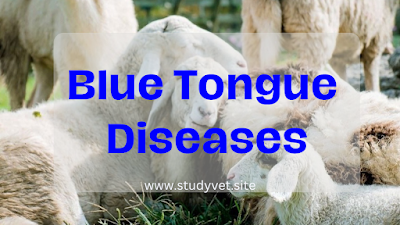Introduction:
As a pet owner, it's essential to be aware of potential health concerns that can affect your beloved animals. Blue Tongue disease is one such issue that can impact not only sheep and cattle but also other livestock.
In this blog post, we will discuss what Blue Tongue is, how it spreads, its symptoms, and what you can do to protect your animals.
What is Blue Tongue?
Blue Tongue, also known as Catarrhal fever of sheep or Sore muzzle of sheep, is an acute infectious disease primarily affecting sheep but can also impact cattle, deer, and goats. It is characterized by fever, inflammation, and ulceration of the buccal mucosa and tongue, leading to the tongue appearing bluish or cyanotic and swollen.
Causes:
The disease is caused by an arthropod-borne orbi virus in the Reoviridae family. It is primarily transmitted by biting insects of the Culicoides genus, which serve as vectors for the virus. Additionally, Blue Tongue can be transmitted through semen from an infected bull.
Incidence:
Blue Tongue was first recognized in South Africa in 1902 and is now reported worldwide in tropical, subtropical, and temperate climates. In India, it is endemic, and the recent incidence of Blue Tongue in sheep, cattle, and buffaloes has seen a significant increase.
Symptoms:
- High fever
- Reddening of nasal and oral mucosa
- Dyspnea and salivation
- Watery discharge from the nostrils, leading to crust formation
- Blue or cyanotic and swollen tongue
- Oedema of lips, nose, ear, and intermandibular space
- Petechiae on the oral and nasal mucosa
- Gangrene
- Coronet hemorrhage leading to lameness
- Respiratory and digestive tract issues, including pneumonia and gastroenteritis
- Haemorrhages in various organs
Understanding the Pathogenesis:
Blue Tongue affects the blood vessels, leading to hyperemia, oedema, and hemorrhage. The virus enters the host and initially replicates in hematopoietic cells, causing viremia. Subsequent replication in endothelial cells results in swelling, degeneration, necrosis, oedema, and thrombosis, affecting hematopoietic tissue and causing anemia and leucopenia.
Diagnosis:
Diagnosing Blue Tongue is based on clinical symptoms such as a bluish tongue and coronet hemorrhages. Additionally, pathognomonic lesions at the base of the pulmonary artery and aorta can be indicative. Laboratory tests, including virus isolation and characterization, and virus neutralization tests, can provide a more definitive diagnosis.
Protecting Your Animals:
1. Vaccination: Consult with your veterinarian about the availability of vaccines to protect your livestock against Blue Tongue.
2. Insect Control: Implement effective insect control measures to minimize the risk of disease transmission through insect bites.
3. Monitoring: Regularly check your animals for any signs of illness, especially if they exhibit symptoms like fever, nasal discharge, and tongue discoloration.
4. Quarantine: Isolate any new animals introduced to your herd or flock to prevent potential disease spread.
Conclusion:
Blue Tongue is a serious disease that can impact your sheep, cattle, or other livestock. Being informed about its causes, symptoms, and prevention measures is crucial for responsible pet ownership. Consult with your veterinarian to ensure the health and well-being of your animals and protect them from this potentially devastating disease.
Your vigilance and care can go a long way in keeping your pets safe and healthy.





Ask! Your doubt or Question.